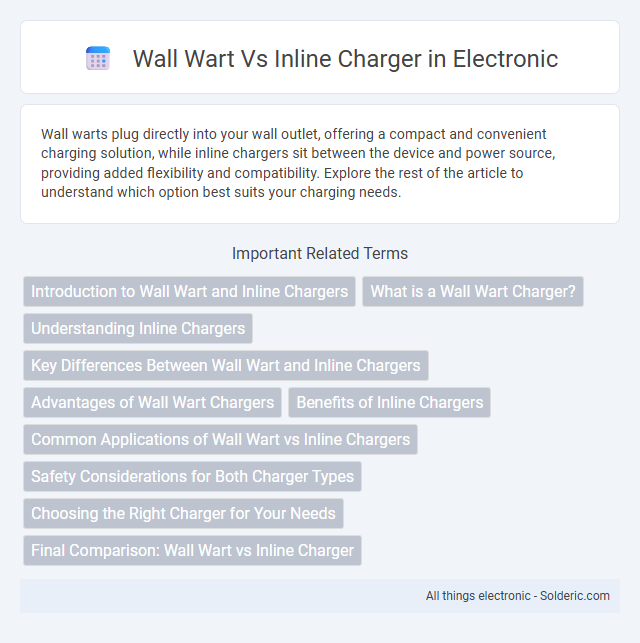Wall warts plug directly into your wall outlet, offering a compact and convenient charging solution, while inline chargers sit between the device and power source, providing added flexibility and compatibility. Explore the rest of the article to understand which option best suits your charging needs.
Comparison Table
| Feature | Wall Wart | Inline Charger |
|---|---|---|
| Definition | External power adapter plugged directly into a wall outlet. | Charger integrated within the power cable between plug and device. |
| Design | Bulky, block-shaped device. | Slender, housed inside the power cord. |
| Portability | Less portable due to size. | More portable and less obtrusive. |
| Heat Dissipation | Better airflow, less heat buildup. | Generally warmer, limited ventilation. |
| Use Cases | Common for charging smartphones, laptops, small appliances. | Used in devices requiring compact power solutions, e.g., headphones. |
| Replacement | Easy to replace separately. | Replacement requires cable change or complex repair. |
| Cost | Generally lower cost. | Usually higher cost due to integrated design. |
| Durability | More robust and less prone to internal cable damage. | Vulnerable to cable wear and tear. |
Introduction to Wall Wart and Inline Chargers
Wall warts and inline chargers serve as power adapters for electronic devices, with wall warts designed to plug directly into a wall outlet, providing compact and convenient power conversion. Inline chargers, on the other hand, integrate the charging circuitry within the cable itself, offering a streamlined charging experience while maintaining portability. Your choice between these adapters depends on the device compatibility and power requirements, optimizing efficiency and usability.
What is a Wall Wart Charger?
A Wall Wart charger is a compact power adapter that plugs directly into a wall outlet to convert AC power to DC for charging electronic devices. Unlike inline chargers, which are integrated within the device's power cable, wall warts are standalone units often used for smartphones, routers, and other small electronics. Your choice between these chargers impacts portability, convenience, and space usage during device charging.
Understanding Inline Chargers
Inline chargers are compact power adapters designed to connect directly between your electronic device and the power source, minimizing clutter and improving portability compared to traditional wall warts. These chargers often feature integrated cables, providing streamlined power delivery and reducing the risk of loose connections. Understanding inline chargers helps you choose efficient, space-saving charging solutions for your devices.
Key Differences Between Wall Wart and Inline Chargers
Wall warts are compact plug-in power adapters that connect directly to an electrical outlet, providing a fixed voltage output for devices, while inline chargers are integrated into the charging cable, offering more flexibility and often featuring built-in connectors for specific devices. Wall warts tend to generate more heat due to their larger transformer components, whereas inline chargers are designed to be lightweight and portable, minimizing bulk. Your choice depends on power requirements, device compatibility, and convenience, with wall warts being ideal for stationary use and inline chargers better suited for mobile or on-the-go charging.
Advantages of Wall Wart Chargers
Wall wart chargers offer compact design and ease of use, making them ideal for bedside or desktop charging without occupying much space. Their fixed plug design ensures a stable connection and reduces the risk of accidental disconnection compared to inline chargers. You benefit from a straightforward charging solution that is often more affordable and widely compatible with various electronic devices.
Benefits of Inline Chargers
Inline chargers offer enhanced safety features by regulating power delivery directly within the cable, reducing risks of overheating and short circuits compared to traditional wall warts. Their compact design improves portability and convenience, making them ideal for travel and on-the-go charging without bulk or clutter. Your devices benefit from more consistent charging performance, prolonging battery lifespan and ensuring efficient energy use.
Common Applications of Wall Wart vs Inline Chargers
Wall warts are commonly used for low-power devices such as routers, cordless phones, and small electronics due to their external power conversion and plug-and-play convenience. Inline chargers are frequently found in applications requiring higher power delivery or portability, like laptop adapters, power tools, and rechargeable battery packs. Your choice depends on the power requirements and the convenience needed for the device's charging setup.
Safety Considerations for Both Charger Types
Wall wart and inline chargers both require careful safety considerations to prevent electrical hazards, including overheating and short circuits. Quality certifications such as UL, CE, or FCC are essential indicators of compliance with safety standards and reliable insulation. Using chargers with built-in overvoltage, overcurrent, and temperature protection mechanisms reduces the risk of device damage and fire hazards in both charger types.
Choosing the Right Charger for Your Needs
Selecting the right charger depends on device compatibility and charging environment; wall warts offer compact, plug-in convenience for stationary use, while inline chargers integrate within cables for portability and reduced clutter. Wall wart chargers typically provide higher power output and faster charging speeds, ideal for home or office settings, whereas inline chargers prioritize mobility for on-the-go charging. Evaluating power requirements, usage frequency, and space constraints ensures optimal performance and longevity for your electronic devices.
Final Comparison: Wall Wart vs Inline Charger
Wall warts offer a compact, plug-and-play solution suited for fixed locations, while inline chargers provide flexibility with detachable cables, enhancing portability and ease of replacement. Your choice depends on the application: wall warts excel in stationary setups with consistent power needs, and inline chargers are better for mobile devices requiring frequent movement or varying cable lengths. Comparing efficiency, wall warts may generate more heat, whereas inline chargers typically deliver more stable power output.
Wall wart vs inline charger Infographic

 solderic.com
solderic.com